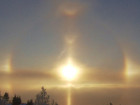|
Defining Planethood
|
|
| midtskogen | Date: Wednesday, 22.06.2016, 07:55 | Message # 196 |
 Star Engineer
Group: Users
 Norway
Norway
Messages: 1674
Status: Offline
| What (detectable) then sets a (sub-)brown dwarf apart from a rogue planet?
NIL DIFFICILE VOLENTI

|
| |
| |
| Watsisname | Date: Wednesday, 22.06.2016, 09:26 | Message # 197 |
 Galaxy Architect
Group: Global Moderators
 United States
United States
Messages: 2613
Status: Offline
| What is meant by a sub brown dwarf? I'm aware of ~13 Jupiter masses being considered the separation of planets from brown dwarfs.
By direct imaging, the only real measurable for a rogue object is its flux, and its distance if we use parallax. Models can then be used to relate that to mass and temperature, which help distinguish between a brown dwarf or a planet.
If detected by gravitational microlensing, then we get its mass.

|
| |
| |
| midtskogen | Date: Wednesday, 22.06.2016, 09:34 | Message # 198 |
 Star Engineer
Group: Users
 Norway
Norway
Messages: 1674
Status: Offline
| Quote Watsisname (  ) What is meant by a sub brown dwarf?
Objects below 13 Jupiter masses formed by the collapse of a gas cloud.
NIL DIFFICILE VOLENTI

|
| |
| |
| steeljaw354 | Date: Wednesday, 22.06.2016, 10:04 | Message # 199 |
 World Builder
Group: Users
 Pirate
Pirate
Messages: 862
Status: Offline
| Well they can also form like stars but with smaller disks.
|
| |
| |
| Watsisname | Date: Wednesday, 22.06.2016, 11:03 | Message # 200 |
 Galaxy Architect
Group: Global Moderators
 United States
United States
Messages: 2613
Status: Offline
| Oh, then I have no idea of an observable property that would determine that.
I think I'm in the camp that would just call such bodies free-floating planets rather than sub-brown dwarf. It's hard for me to think of the formation setting being important for what we call it if it's correct that we can't tell the difference.

|
| |
| |
| steeljaw354 | Date: Monday, 15.08.2016, 13:04 | Message # 201 |
 World Builder
Group: Users
 Pirate
Pirate
Messages: 862
Status: Offline
| 1) Orbits one or more stars or stellar remnants
2) Is in hydrostatic equilibrium
3) Doesn't undergo fusion currently or in the past
4) Doesn't orbit another object that applies to this set of rules. Or else it's a moon.
I have revamped my set of rules, is it better? Why do some people even include the orbital clearing? Is an excuse to avoid a large number?
Edited by steeljaw354 - Monday, 15.08.2016, 13:07 |
| |
| |
| midtskogen | Date: Monday, 15.08.2016, 17:31 | Message # 202 |
 Star Engineer
Group: Users
 Norway
Norway
Messages: 1674
Status: Offline
| Quote Watsisname (  ) There could be a useful approach in that the accretion phase of planet growth doesn't last very long relative to the age of the system -- but then again that also depends on the mass of the star. What if we're dealing with high mass stars? So... it's more complicated than we might like. It works well for our system and we think other sun-like and low-mass systems.
Proto-planets could stop being proto-planet once it reaches some level of maturity regardless of what's left in its orbit. I'm not sure. I think what I don't like about "cleared its neighbourhood" in the current defintion isn't really the whether it's a completely worthy planet or not, but that those planets which don't qualify are to be a single group called dwarf planets. In our solar system they're all dwarfs and will never reach full planethood, but some in other solar systems might not even be "dwarfs" at all. By this definition our Neptune, Saturn and perhaps Jupiter were at some point "dwarf planets", which is a poor name, but it might be useful to distinguish between planets that will likely reach planethood and those which never will.
NIL DIFFICILE VOLENTI

Edited by midtskogen - Monday, 15.08.2016, 17:32 |
| |
| |
| steeljaw354 | Date: Monday, 15.08.2016, 17:44 | Message # 203 |
 World Builder
Group: Users
 Pirate
Pirate
Messages: 862
Status: Offline
| Why are these objects not planets in your view? Does the orbit/neighborhood actually matter? It's the physical characteristics of the object we should be using to define it. Moons aside.
|
| |
| |
| Watsisname | Date: Wednesday, 17.08.2016, 07:20 | Message # 204 |
 Galaxy Architect
Group: Global Moderators
 United States
United States
Messages: 2613
Status: Offline
| Quote midtskogen (  ) Proto-planets could stop being proto-planet once it reaches some level of maturity regardless of what's left in its orbit. I'm not sure. I think what I don't like about "cleared its neighbourhood" in the current defintion isn't really the whether it's a completely worthy planet or not, but that those planets which don't qualify are to be a single group called dwarf planets. In our solar system they're all dwarfs and will never reach full planethood, but some in other solar systems might not even be "dwarfs" at all. By this definition our Neptune, Saturn and perhaps Jupiter were at some point "dwarf planets", which is a poor name, but it might be useful to distinguish between planets that will likely reach planethood and those which never will.
Yeah, I get that. Soter's "orbit-clearing" discriminant implies still-growing gas giants are still called dwarf planets, even if they're several Earth masses. Which is kind of silly. But I think the idea is that this criterion is meant for mature systems, not young ones where accretion is still an important process and the objects are evolving quickly. I don't think we would seriously call a nascent Jovian a "dwarf planet".
Margot's Pi is interesting in this case -- it would call the still-growing Jovian a planet once it surpassed the orbit-clearing mass. Personally, that's what I like about Margot's Pi. It doesn't even consider how much stuff remains in the orbit. It doesn't care if the orbit is 'clear' or not. It brings us directly to the accretion-scattering dynamics in young systems which result in Soter's discriminant working in mature systems. But by the same token, it also doesn't account for binary planets, or Earth-Theia situations.
Quote steeljaw354 (  ) Why are these objects not planets in your view? Does the orbit/neighborhood actually matter? It's the physical characteristics of the object we should be using to define it. Moons aside.
Physical characteristics are important, but I agree with the astronomical community in thinking that the dynamics are important as well. Think of the graphic I showed in the Q&A thread for Margot's Pi: the orbit-clearing threshold depends not just on the mass of the object, but also how far from its star it is orbiting! So location does matter.  We say that the 'clearing' of the orbit is important because it's a result of the processes that build a planet from a bunch of rocks. We say that the 'clearing' of the orbit is important because it's a result of the processes that build a planet from a bunch of rocks.

|
| |
| |
| steeljaw354 | Date: Wednesday, 17.08.2016, 13:58 | Message # 205 |
 World Builder
Group: Users
 Pirate
Pirate
Messages: 862
Status: Offline
| Location doesn't matter, if a planet is jupiter sized and hasn't cleared it's orbit, people will say it's a dwarf planet, it makes 0 sense. Classification by location makes no sense, moons aside. So what if it's orbit is to far from it's star? It's still a planet regardless of it's orbital location or if it's cleared or not.
Edited by steeljaw354 - Wednesday, 17.08.2016, 14:04 |
| |
| |
| spacer | Date: Wednesday, 17.08.2016, 14:04 | Message # 206 |
 Star Engineer
Group: Users
 Israel
Israel
Messages: 1258
Status: Offline
| Quote steeljaw354 (  ) Classification by location makes no sense
wats just showed it is make sense. because the location is matter. if an object is father from the star, it will also move slower.
and the location will also related to the past. what was in that location billions of years ago. where the planets formed etc.
but wats will explain better 
"we began as wanderers, and we are wanderers still"
-carl sagan
-space engine photographer
|
| |
| |
| steeljaw354 | Date: Wednesday, 17.08.2016, 14:05 | Message # 207 |
 World Builder
Group: Users
 Pirate
Pirate
Messages: 862
Status: Offline
| Even if the object is jupiter sized and it's orbit isn't clear?
|
| |
| |
| spacer | Date: Wednesday, 17.08.2016, 14:12 | Message # 208 |
 Star Engineer
Group: Users
 Israel
Israel
Messages: 1258
Status: Offline
| a jupiter sized planet orbit will be probably clear by its own gravity.
"we began as wanderers, and we are wanderers still"
-carl sagan
-space engine photographer
Edited by spacer - Wednesday, 17.08.2016, 14:14 |
| |
| |
| steeljaw354 | Date: Wednesday, 17.08.2016, 14:20 | Message # 209 |
 World Builder
Group: Users
 Pirate
Pirate
Messages: 862
Status: Offline
| Not if you have a really massive star like something like Rigel, and massive stars like that usually have large disks. The more massive the star, the more massive the disk, how big does "orbital clearing" have to be? Why does a planet need to clear it's orbit?
How do you expect something jupiter sized to clear something like that?

Edited by steeljaw354 - Wednesday, 17.08.2016, 14:20 |
| |
| |
| Watsisname | Date: Wednesday, 17.08.2016, 17:00 | Message # 210 |
 Galaxy Architect
Group: Global Moderators
 United States
United States
Messages: 2613
Status: Offline
| Quote steeljaw354 (  ) The more massive the star, the more massive the disk, how big does "orbital clearing" have to be?
It doesn't have to clear the whole disk. Just its orbital space, defined with respect to its Hill Sphere. Margot uses 2sqrt(3) of the Hill Sphere radius as the minimum range for a planet to clear. The motivation for that choice is that this is the size of the feeding zone of the planet, and this is consistent with simulations for a wide range of possible systems.
How effective the body is at clearing that space depends on the transference of orbital energy by scattering, or the direct removal by accretion. Here's the formula:

This shows that for a star the mass of Rigel, 1 Jupiter mass is not enough to clear an orbit at more than 100 AU. That's not because the disk is too massive. It's because the orbit is too far out (where they are slow), and a star that massive doesn't live long enough. This is why there is a disk there at that distance and not planets. The definition you think makes no sense proves the image that you show.
Massive stars like the A's and B's can form planets, but they are closer in. There are also strong winds and evaporation of the disk by the intense radiation. Forming planets around high mass stars is hard, and they must form very quickly or not at all.

|
| |
| |